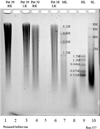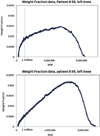Hyaluronan molecular weight distribution is associated with the risk of knee osteoarthritis progression
- PMID: 25266961
- PMCID: PMC4375131
- DOI: 10.1016/j.joca.2014.09.017
Hyaluronan molecular weight distribution is associated with the risk of knee osteoarthritis progression
Abstract
Objective: We investigated the relationship between the molecular weight (MW) distribution of hyaluronan (HA) in synovial fluid (SF) and risk of knee osteoarthritis (OA) progression.
Methods: HA MW was analyzed for 65 baseline knee SFs. At 3-year follow-up, knees were scored for change in joint space narrowing (JSN), osteophyte (OST) progression, or occurrence of total knee arthroplasty (TKA). HA MW distribution was analyzed using agarose gel electrophoresis (AGE), and its relationship to OA progression was evaluated using logistic regression. The association between HA MW and self-reported baseline knee pain was analyzed using Pearson's correlation coefficients.
Results: Knee OA was categorized as non-progressing (OST-/JSN-, 26 knees, 40%), or progressing based on OST (OST+/JSN-, 24 knees, 37%), OST and JSN (OST+/JSN+, 7 knees, 11%) or total knee arthroplasty (TKA, 8 knees, 12%). The MW distribution of HA in baseline SFs was significantly associated with the odds of OA progression, particularly for index knees. After adjusting for age, gender, BMI, baseline X-ray grade and pain, each increase of one percentage point in %HA below 1 million significantly increased the odds of JSN (odds ratios (OR) = 1.45, 95% CI 1.02-2.07), TKA or JSN (OR = 1.24, 95%CI 1.01-1.53) and the odds of any progression (OR = 1.16, 95% CI 1.01-1.32). HA MW distribution significantly correlated with pain.
Conclusion: These data suggest that the odds of knee OA progression increases as HA MW distribution shifts lower and highlight the value of reporting MW distribution rather than just average MW values for HA.
Keywords: Hyaluronan; Molecular weight; Osteoarthritis progression; Synovial fluid.
Copyright © 2014 Osteoarthritis Research Society International. Published by Elsevier Ltd. All rights reserved.
Conflict of interest statement
No authors report any conflict of interest.
Figures


Similar articles
-
Serum hyaluronic acid concentration predicts the progression of joint space narrowing in normal knees and established knee osteoarthritis - a five-year prospective cohort study.Arthritis Res Ther. 2015 Oct 10;17:283. doi: 10.1186/s13075-015-0793-0. Arthritis Res Ther. 2015. PMID: 26453426 Free PMC article.
-
Effect of intraarticular hyaluronan injection on synovial fluid hyaluronan in the early stage of canine post-traumatic osteoarthritis.J Rheumatol. 2001 Jun;28(6):1341-6. J Rheumatol. 2001. PMID: 11409129
-
Differences in the osteoarthritic synovial fluid composition and rheology between patients with or without flare: a pilot study.Clin Exp Rheumatol. 2012 Sep-Oct;30(5):729-34. Epub 2012 Oct 17. Clin Exp Rheumatol. 2012. PMID: 22935334
-
Potential mechanism of action of intra-articular hyaluronan therapy in osteoarthritis: are the effects molecular weight dependent?Semin Arthritis Rheum. 2002 Aug;32(1):10-37. doi: 10.1053/sarh.2002.33720. Semin Arthritis Rheum. 2002. PMID: 12219318 Review.
-
Different molecular weights of hyaluronan research in knee osteoarthritis: A state-of-the-art review.Matrix Biol. 2023 Mar;117:46-71. doi: 10.1016/j.matbio.2023.02.006. Epub 2023 Feb 26. Matrix Biol. 2023. PMID: 36849081 Review.
Cited by
-
Methods for isolating and analyzing physiological hyaluronan: a review.Am J Physiol Cell Physiol. 2022 Apr 1;322(4):C674-C687. doi: 10.1152/ajpcell.00019.2022. Epub 2022 Feb 23. Am J Physiol Cell Physiol. 2022. PMID: 35196167 Free PMC article. Review.
-
Hyaluronic acid has chondroprotective and joint-preserving effects on LPS-induced synovitis in horses.J Vet Sci. 2019 Nov;20(6):e67. doi: 10.4142/jvs.2019.20.e67. J Vet Sci. 2019. PMID: 31775194 Free PMC article.
-
Structural insights into translocation and tailored synthesis of hyaluronan.Nat Struct Mol Biol. 2025 Jan;32(1):161-171. doi: 10.1038/s41594-024-01389-1. Epub 2024 Sep 25. Nat Struct Mol Biol. 2025. PMID: 39322765 Free PMC article.
-
Pain Relieving Effect of-NSAIDs-CAIs Hybrid Molecules: Systemic and Intra-Articular Treatments against Rheumatoid Arthritis.Int J Mol Sci. 2019 Apr 18;20(8):1923. doi: 10.3390/ijms20081923. Int J Mol Sci. 2019. PMID: 31003542 Free PMC article.
-
Increasing Concentration of Sinovial: Effect on Cartilage Protection in a Rabbit ACLT Model.Cartilage. 2021 Dec;13(2_suppl):185S-195S. doi: 10.1177/1947603520905363. Epub 2020 Feb 18. Cartilage. 2021. PMID: 32070117 Free PMC article.
References
-
- Balazs EA, Sundblad L. Viscosity of hyaluronic acid solutions containing proteins. Acta Soc Med Ups. 1959;64:137–146. - PubMed
-
- Balazs EA. Viscosity of hyaluronic acid solutions containing proteins. Acta Soc Med Ups. 1959;64 - PubMed
-
- Ropes M, Robertson WB, Rossmeisl EC, Peabody RB, Bauer W. Synovial fluid mucin. Acta Med Scand. 1947;128:700.
-
- Sundblad L. Studies on hyaluronic acid in synovial fluids. Acta Soc Med Ups. 1953;58 - PubMed
Publication types
MeSH terms
Substances
Grants and funding
LinkOut - more resources
Full Text Sources
Other Literature Sources

